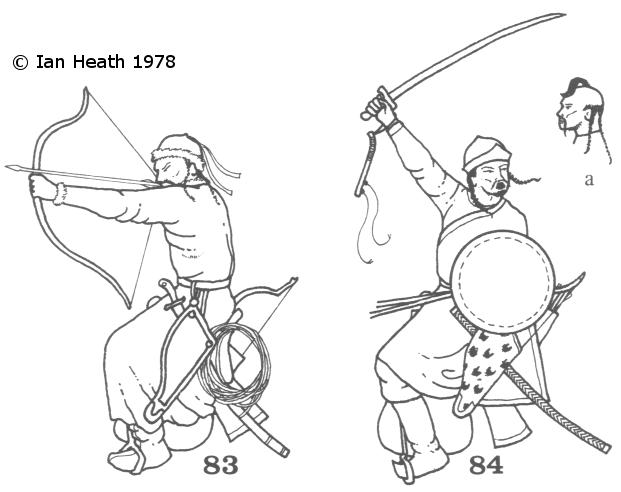
Try Amazon Audible Plus
MONGOL LIGHT CAVALRYMEN
An extract from Armies and Enemies of the Crusades 1096-1291by Ian Heath
 |

 |
83 & 84. MONGOL LIGHT CAVALRYMEN
Mongol costume and equipment is described fairly thoroughly in contemporary sources. William of Rubreck records that in summer the Mongols wore silks, rich brocades and cottons from China and Persia, and Friar John de Plano Carpini probably intends the same materials when he speaks of buckram, 'purple' and baldequin. Marco Polo also speaks of cloth of gold (brocade) and silk, lined or decorated with sable, ermine, squirrel and fox fur. One type of Chinese shirt, first recorded in 1219, was of raw silk worn as a type of armour since arrows could not penetrate it, instead being driven into the skin so that by tugging on the shirt the arrowhead could be extracted from the wound cleanly.
In winter fur coats and breeches were worn, usually 2 of the former, the inner coat with the fur on the inside and the outer with it outside. The outer coat was of wolf, fox, monkey, badger, dog or goat skin depending on the social status of the wearer. Sheepskin and stuffed silk were also worn, plus felt which served as a type of light armour.
Carpini mentions white, red and blue-purple tunics as well as baldequin. H. H. Howorth, describing the dress of mid-19th century Mongols, says the usual colours for the outer summer coat (the Kalat) were blue or brown, over a bright blue or grey shirt; trouser colours appear to have been similar. The flap-opening of the Kalat went from left to right, as opposed to the right-over-left opening of the Turks (see note 55/56). An ornamental belt, round fur or plush-trimmed cap and leather boots with felt soles completed the costume. Howorth adds that at that late date the cap had two 45 cm ribbons hanging down at the back, and these appear to be mentioned in at least one contemporary source of our period. The alternative hat worn by 84 is a Saraquj.
Polo records basic Mongol equipment as bow, mace and sword (other sources describe the latter more accurately as a curved, one-edged sabre). Apparently 2 or 3 bows were carried, or else one particularly good one, and 3 large quivers of arrows. Polo speaks of only 60 arrows being carried, '30 smaller ones for piercing and 30 larger with broad heads for discharging at close quarters'; armour-piercing arrows were also in use. All had eagle-feather flights. Carpini's report indicates that the arrows were 28-30" long; another source says they were longer than European arrows and had iron, bone or horn heads 3" broad. The bow was both longer and capable of greater range than the type in use with the Turks and Mamluks.
Other arms were lasso, dagger, and lance, the latter often with a small hook below the head to pull enemy horsemen from the saddle. Vincent de Beauvais, however, says few Mongols carried lances and Carpini seems to confirm this.
Polo records shields in one passage and Carpini says that wicker shields were carried, though he adds that they were not used much because they interfered with the use of the bow and that he only saw them in use in camp at night by guardsmen such as the Keshik. Meng Hung (a Chinese general contemporary to Genghis Khan) seems to disagree since he lists 4 types of Mongol shield: large, of hide or willow wood (the latter possibly meaning it could be of interwoven osiers); a smaller type used by front rank light troops to deflect arrows; large 'tortoise' shields for use in siege-work; and apparently a type of face-visor.
84a depicts how the Mongols wore their hair. The crown was shaved right round, leaving just a long lock of hair on the very top of the head which hung down to the eyebrows. The back of the head was also shaved. At the sides they grew their hair long 'like women', plaiting it behind the ears. Rubreck indicates that there could also be a plait at the back of the head. Compare to the hairstyle of 50.
Moustaches could be grown to extravagent length, though Carpini says only a few grew hair on their top lips. All the sources agree that beards were scanty.